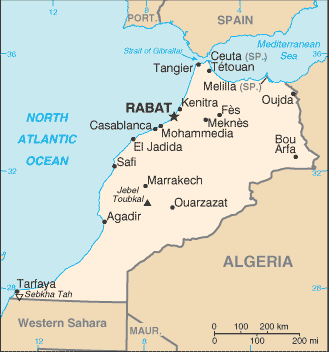|
Morocco
|

|
Capital: Rabat
Population: 36,471,769
Brief History of Morocco:
Morocco is located strategically at the entry to the Mediterranean Sea. As a result, its coastal lands became prized areas for the empires that ruled the Mediterranean. Starting with the Phoenicians, many empires established settlements in Morocco including the Romans, the Visigoths, the Vandals, and the Byzantine Empire. In the 7th century, the Arabs conquered Morocco and brought with them the Islam religion as well as the Arab culture. In the 15th century, Portugal tried to control Morocco's Atlantic coast. Later in 1830 France began to show interest in Morocco. In 1912 the Treaty of Fez made Morocco a protectorate of France.
After World War II, the people of Morocco began to desire independence. When France exiled popular leader Sultan Mohammed V and replaced him with Mohammed Ben Aarafa, the people began to rebel. In 1955 France allow Mohammed V to return and granted Morocco independence in 1956.
Morocco has been internally ruled by the Alaouite dynasty since 1649. Hassan II was king from 1961 to 1999. When he died he was replaced by his son Mohammed VI.
The Geography of Morocco
Total Size: 446,550 square km
Size Comparison: slightly larger than California
Geographical Coordinates: 32 00 N, 5 00 W
World Region or Continent: Africa
General Terrain: northern coast and interior are mountainous with large areas of bordering plateaus, intermontane valleys, and rich coastal plains
Geographical Low Point: Sebkha Tah -55 m
Geographical High Point: Jebel Toubkal 4,165 m
Climate: Mediterranean, becoming more extreme in the interior
Major cities: Casablanca 3.245 million; RABAT (capital) 1.77 million; Fes 1.044 million; Marrakech 909,000; Tangier 768,000 (2009)
The People of Morocco
Type of Government: constitutional monarchy
Languages Spoken: Arabic (official), Berber dialects, French often the language of business, government, and diplomacy
Independence: 2 March 1956 (from France)
National Holiday: Throne Day (accession of King MOHAMED VI to the throne), 30 July (1999)
Nationality: Moroccan(s)
Religions: Muslim 98.7%, Christian 1.1%, Jewish 0.2%
National Symbol: pentacle symbol; lion
National Anthem or Song: Hymne Cherifien (Hymn of the Sharif)
Economy of Morocco
Major Industries: phosphate rock mining and processing, food processing, leather goods, textiles, construction, tourism
Agricultural Products: barley, wheat, citrus, wine, vegetables, olives; livestock
Natural Resources: phosphates, iron ore, manganese, lead, zinc, fish, salt
Major Exports: clothing, fish, inorganic chemicals, transistors, crude minerals, fertilizers (including phosphates), petroleum products, fruits, vegetables
Major Imports: crude petroleum, textile fabric, telecommunications equipment, wheat, gas and electricity, transistors, plastics
Currency: Moroccan dirham (MAD)
National GDP: $163,500,000,000
** Source for population (2012 est.) and GDP (2011 est.) is CIA World Factbook.
Back to Geography Home Page
